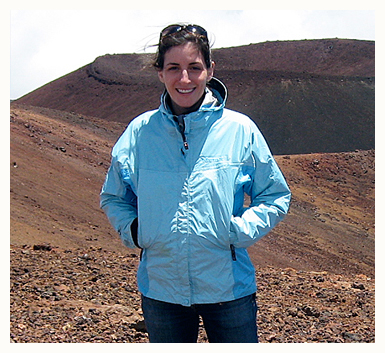Sharon Wilson Purdy
Research scientist, Center for Earth and Planetary Studies
 What’s your current position (and where) and what does your research/work focus on?
What’s your current position (and where) and what does your research/work focus on?
I am a research scientist at the Smithsonian
Center for Earth and Planetary Studies
at the National Air and Space Museum in Washington, DC. I am also a Ph.D. candidate in the
Department of Environmental Sciences
at the University of Virginia. My research focuses on the geology and geomorphology of landforms on Mars that were formed or modified by water, such as alluvial fans and valleys.
The goal of my work is to understand when, where, how much and how long water was flowing on the surface of Mars to gain insight into the climate history and habitability of the planet.
What got you interested in planetary science?
Geology is a field of study that combines my interests in math, science and the great outdoors with the challenge and excitement of new discoveries. As a senior at Middlebury College,
I analyzed the geochemistry of igneous rocks in Vermont that formed over 400 million years ago, linking the rocks to an extensional tectonic event between the Taconic and Acadian orogenies
(collisions of land masses that formed the Appalachian mountains). Rocks provide a record of a planet’s environmental history, a window into the past. Geologists are like detectives that
decode the clues in rocks to understand how and when the rock formed, and how the planet has changed over time. I became hooked on planetary science during an internship at the Smithsonian
Natural History Museum where I investigated the geochemistry of Lafayette, an igneous meteorite from Mars that had been altered by water. I love studying Mars because it is
Earth-like in many ways yet is full of mystery and surprise. Through my research, I have traveled to remote places on Earth, worked on several research teams and been involved
in science missions such as HiRISE.
Why is your subject of study/research important to you?
Humans are hard wired to explore and try to make sense of the world around them. Earth is a planet teeming with life but we have not yet discovered evidence of life elsewhere in
our solar system. My research focuses on understanding the role of liquid water on Mars because life as we know it on Earth is intimately associated with water. Researchers in the
field of planetary science work together as a community to provide pieces of a much greater planetary puzzle; the aggregate of our work achieves far more than any single research result.
We are in amazing times for space exploration and I believe we are on the brink of answering many fundamental questions about life in our solar system.
What would you suggest to a young person to study if he/she is interested in planetary science?
Scientific research can be slow and requires patience and dedication. If you start with a background in terrestrial geology, you can apply your knowledge of Earth processes to study other
planets or moons. You may love science but pay attention in English class too—being able to effectively communicate your results through publications in scientific journals is important!
About HiRISE
The HiRISE camera onboard the Mars Reconnaissance Orbiter is the most powerful one of its kind ever sent to another planet. Its high resolution allows
us to see Mars like never before, and helps other missions choose a safe spot to land for future exploration.
NASA’s Jet Propulsion Laboratory, a division of the California Institute of Technology in Pasadena, Calif., manages the Mars Reconnaissance
Orbiter for NASA’s Science Mission Directorate, Washington. Lockheed Martin Space Systems is the prime contractor for the project and
built the spacecraft. The HiRISE camera was built by Ball Aerospace & Technologies Corp. and is operated by the
University of Arizona.
 What’s your current position (and where) and what does your research/work focus on?
What’s your current position (and where) and what does your research/work focus on?